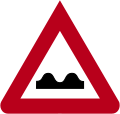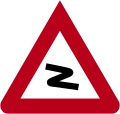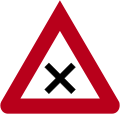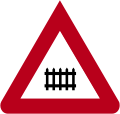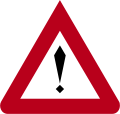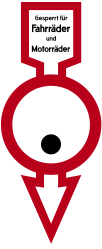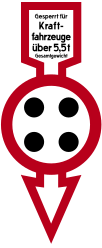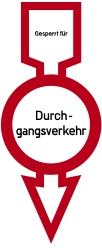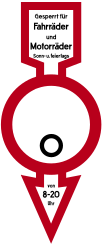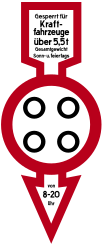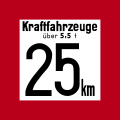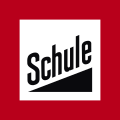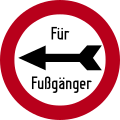Illustration of the traffic signs in the German Reich from 1927 to 1934
The picture table of the traffic signs in the German Reich from 1927 to 1934 shows the traffic signs in the German Reich during the Weimar Republic , as defined by the new version of the regulation on warning signs for motor vehicle traffic of July 8, 1927 . This ordinance was the last forerunner of the bill first mentioned in the 1934 version of the " Reichs-Straßenverkehrs -ordnung (RStVO)". The ordinance on warning signs came into force on September 1, 1927. At the same time, the ordinance passed in 1925, which had confirmed the traffic signs from the 1910 Reich Law Gazette, lost its validity. The traffic signs specified there remained permitted until December 31, 1930. The law on motor vehicle traffic of July 21, 1923 , however, remained in force.
The ordinance of 1927 was a brief, complete new version, which was supplemented again in 1932. A major concern of the 1927 ordinance was to keep up to date with the changed international guidelines for traffic signs. The 1932 amendment focused on the signage at the railroad crossings. The reason for the redesign of the sign was the steady, sometimes sudden increase in automobile traffic that went hand in hand with the decrease in horse-drawn carriages. In addition, the sustained increase in the average travel speed due to newly registered vehicles presented the local police authorities with ever new tasks. This led to a proliferation of local police regulations and notices, which made it almost impossible for non-local drivers to drive through a place they did not know with impunity. When standardizing the many locally valid traffic signs, the makers had the USA in mind. There were already standardized traffic signs here. The previous three types of traffic signs that were already valid in Germany - the international warning signs, the speed limit signs and the blocking signs - were seen as not being flexible enough for the individual locations required. In addition, with the rectangular and square signs, drivers had the difficulty of recognizing them reliably, as their unspecific shape led to confusion with billboards of all kinds.
Colours
The color scheme has not yet been defined by the requirements of the Reich Committee for Delivery Conditions (RAL), but rather generally defined as "black", "white" and "signal red", with "signal red" not being a standardized color. The RAL also presented the first color catalog (RAL 840) with 40 colors in 1927.
Manufacturing specifications and installation
All signs, which were without exception warning signs, were formed by an equilateral triangle with a red border. The side length was 105 centimeters, the thickness of the red border 12 centimeters. Within built-up areas, the boards were only allowed to be set up in particularly dangerous places and could then have a side length of 70 centimeters as a smaller version. The red border was then 8 centimeters thick. As a target it was determined that the two lower corners could be slightly rounded. This is how the panels were presented in their illustrations. The boards should be set up 150 to 250 meters in front of the danger zone. The posts had to be painted white and could also be provided with "colored horizontal stripes" as a target regulation. If a board had to be erected less than 150 meters in front of a danger point, the distance to the danger point had to be indicated as a black number on an additional white board. Advertising was prohibited on the billboards.
Warning signs, annex to § 3
More signs and boards
The following signs and boards were not published in the Reichsgesetzblatt. Large cities such as Berlin, Hamburg, Leipzig and Dresden had teamed up since the mid-1920s to clear the inconsistently arranged forest of signs of the respective local police authorities and to create clarity for road users. The new signs were published, among other things, in their own urban street codes and ultimately legally valid for all of Germany. The “Berlin Road Code” introduced on January 15, 1929, for example, replaced 200 different Berlin police regulations on road and traffic law. In some cases, individual ordinances had previously only applied in certain urban areas in Berlin and differed from one another in terms of content even if the facts were the same. The shape, design and color of the new signs were determined through agreements between the states and the competent Reich authorities.
Berlin Road Code (1929)
Appendix I. International warning signs
These signs corresponded to the signs shown above from the ordinance on warning signs for motor vehicle traffic of July 8, 1927 .
Appendix II. Blocking signs for permanent blockages
- expiring from January 1, 1935 -
Blocked for:
Annex III. Blocking signs for closures on Sundays and public holidays
- expiring from January 1, 1935 -
Point code as with permanent blocks:
Appendix IV. Speed signs for maximum speeds
- expiring from January 1, 1935 -
Appendix V. Speed signs for slow driving in front of schools and hospitals
Annex VI. Directional signs for prescribed routes
- expiring from January 1, 1935 -
In general
At intersections
Annex VIl. Installation sketch for direction signs at road crossings
Annex VIII. Signs for one-way streets, first-order traffic streets and main traffic routes
Annex IX. Signs for parking lots, parking bans, pedestrian crossings, riding and cycling paths
Signs for pedestrian crossings
Signs for riding and cycling routes
, P. 578 ff .; here:
Prussian Police Costs Act (1929)
In Prussia, further traffic signs were regulated by the Police Costs Act of August 2, 1929. This decree regulates signposts, place-name signs, mandatory and prohibited signs, signaling devices, blocking equipment during construction work and much more. Other German states also issued regulations on traffic signs, which in many cases coincided with those of the Police Costs Act. For the first time since the 19th century, modern signposts and place-name signs were set up on a large scale to accommodate car traffic.
Automobile club traffic signs
Towards the end of the 1920s, the state also began to realize that the installation of contemporary signposts and place-name signs was one of the particularly important aspects of the steadily growing automobile traffic. Until then, the establishment of these symbols in Germany was exclusively in the hands of the automobile clubs that were also very active in this area. In the 1920s, for example, the German Touring Club began to set up signposts in the most important German traffic regions. By 1930 the association had put up around 32,000 signs. The signs had a uniform design; the lower field was reserved for the companies that had made a financial contribution to the manufacture of the tablet. The Bavarian Automobile Club also set up blue and white warning signs in Bavaria, which in their basic form were based on the state signs for maximum speeds.
With the appearance of the new Prussian Police Cost Act of 1929, the subsequent state initiatives and the introduction of the Reich Road Traffic Regulations in 1934, the setting up of traffic signs by the automobile clubs had outlived itself. They have now been quickly replaced by the state decreed symbols.
Place-name sign of the General German Automobile Club
Curbstones
The law on the traffic with motor vehicles of July 21, 1923 stated according to paragraph 5a that dangerous road sections, which were used for through traffic, should be protected by warning signs. Railway crossings, road bends and curves were considered to be special danger points. In addition to the warning signs, these danger points could also be secured with curbstones. The white paint on curvatures of bouncing stones with a square cross-section or trees there had a particularly good effect. On the first longer autobahn in Germany, the four-lane motor vehicle road Cologne-Bonn, opened in 1932, so-called "directional stones" were set up along the broad shoulder , which clearly delimited the lane at a distance of around 33.30 meters, even in poor visibility. The stones had a square cross-section and were carved in a truncated pyramid shape at the top. They were painted white at the bottom, the head was dyed black to remain visible in winter. The stone was 0.60 meters high above the top of the terrain, but only about 0.30 meters deep in the ground. Due to their shallow depth, the stone should be able to give way in the event of an impact in an accident and not increase the damage by anchoring it too firmly.
Fuses for crossings at rail height
Warning crosses
These signs at rail-level crossings were not part of the ordinance on warning signs for motor vehicle traffic of July 8, 1927 . Their arrangement and set-up were regulated by the Reich Railway Directorate through the ordinance on the introduction of new railway building and operating regulations of July 17, 1928, which replaced the previously valid railway building and operating regulations of November 4, 1904 . After that, when the new ordinance came into force on October 1, 1928, the following warning crosses were introduced. The older warning signs have gradually been replaced by these warning crosses. According to the new regulation, the post on which the signs were attached had to be 2.50 meters high from the lower tips of the warning crosses to the floor.
The Reichsbahnschranke was introduced in 1932 and is still in operation today.
Warning lights
As early as 1925, experiments were carried out with electrically controlled level crossings, but it took another decade before the systems were fully developed. In October 1929 the Deutsche Reichsbahn gave the first approval for the establishment of two different test systems. The first was built by the ADAC on the Königs Wusterhausen-Beeskow line, the second near Friedersdorf was built by the United Railway Signal Works. Both indicators had a lantern fed with acetylene , in which the color change from white to red was achieved by an electrically controlled shutter.
Halt signs
Level crossings were additionally secured near the rail height by white, rectangular warning signs, most of which had a black border. These signs, which were often punched from sheet metal, did not have uniformly regulated labels that were intended to make road users aware of the dangers and / or prohibitions at barrier-free and barrier-free level crossings. It was common to all of these signs that they began with the particularly capitalized word “Halt!”.
Stop signs for postal services
The Reichspost signs underlaid with the imperial eagle only became obsolete when the stop signs announced on July 28, 1939 .
Stop signs for postal services
literature
- Heinrich Paetsch: The Prussian police cost law and the traffic signs. The Prussian guidelines on the type, scope and technical design of traffic facilities. In: Verkehrstechnik. 22, 1930, pp. 265-268.
- Dietmar Fack: Automobiles, traffic and education. Motorization and socialization between acceleration and adaptation 1885–1945. Leske + Budrich, Opladen 2000, ISBN 3-8100-2386-8 .
Web links
Remarks
- ↑ a b c Reichsgesetzblatt , year 1927, No. 29, date of issue: Berlin, July 15, 1927, p. 177 ( page 177 , page 178 ).
- ^ Reichsgesetzblatt , Volume 1932, No. 29, date of issue: Berlin, May 26, 1932, p. 227.
- ↑ International Agreement on Motor Vehicle Traffic of April 24, 1926; Reichsgesetzblatt , II 1930, p. 1233.
- ^ Ernst Schuppan: Uniform traffic regulation in Germany. In: Automobil-Rundschau. 3, Volume 29, 1927, p. 57.
- ↑ The table can also be found in a very early publication in: Carl Marcussen (Ed.): The legal and police regulations of July 28, 1926 that are decisive for the driver of a motor vehicle . Marcussen, 1927.
- ^ Dietmar Fack: Automobile, traffic and education. Motorization and socialization between acceleration and adaptation 1885–1945. Leske + Budrich, Opladen 2000, ISBN 3-8100-2386-8 , p. 252.
- ↑ Police Ordinance on the Regulation of Traffic and the Maintenance of Order in the Streets of Berlin of January 15, 1929.
- ↑ Joachim Rott: "I walk my way straight ahead unhindered": Dr. Bernhard Weiss (1880–1951). Police Vice President in Berlin. Live and act. Frank & Timme, Berlin 2010, ISBN 978-3-86596-307-9 , p. 117.
- ↑ Erwin Neumann: The modern road construction. Tasks and technology. Springer, Berlin 1927, p. 375.
- ^ Robert Allmers, Robert Kaufmann, Carl Fritz, Ernst Kleinrath, Friedrich Pflug (eds.): The German automobile industry of the present. Reimar Hobbing, Berlin 1928, p. 219.
- ↑ Fig. 1 meant locked for bicycles and motorcycles ; Picture 2 stood for blocked for motor vehicles, except motorcycles ; Image 3: Blocked for vehicles of all kinds ; Fig. 4: Blocked for vehicles over 5.5 tons total weight ; Image 5: Blocked for vehicles of all types ; Image 6: Closed to through traffic .
- ↑ Fig. 1: Closed for bicycles and motorcycles - Sundays and public holidays ; Figure 2: Closed to motor vehicles, except for motorcycles - Sundays and public holidays ; Image 3: Closed to all types of vehicles - Sundays and public holidays ; Fig. 4: Blocked for vehicles over 5.5 tons total weight - Sundays and public holidays ; Photo 5: Closed to vehicles of all types - Sundays and public holidays .
- ^ Ernst Heymann : The new Reich road traffic law. In: The parish day. Journal for German community politics. 22, 1934, p. 578 ff .; here: p. 581.
- ^ The German Touring Club (DTC). From a cyclist's association to a powerful motorist association. In: German press. 20th year (1930), p. 314 ff .; here: p. 315.
- ↑ Erwin Neumann: The modern road construction. Tasks and technology . (= Robert Otzen (Hrsg.): Reference library for civil engineers. 10). Springer, Berlin / Heidelberg 1932, pp. 95-96.
- ^ "Kraftwagenstrasse Köln-Bonn" (probably 1932), p. 28.
- ^ Ordinance on the introduction of new railway building and operating regulations from July 17, 1928. In: Reichsgesetzblatt. Year 1928, No. 37, date of issue: Berlin, 7 August 1928, p. 541 ff.
- ↑ Dirk Kolling: The way to today's level crossing safety technology. In: Yearbook of the Railway System 2010. 175 years of railways in Germany. Pp. 118-121; here: p. 120.
- ↑ E. Behr: Securing path crossings at rail height. In: VDI magazine. Volume 82, No. 34, 1939, pp. 965 ff .; here: p. 969.
- ^ Order of the Reich Minister of Transport for the introduction of uniform stop signs for trams and motor vehicle lines . From July 19, 1939. In: Reichsverkehrsblatt. B, No. 33, of July 29, 1939.


